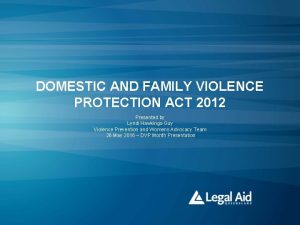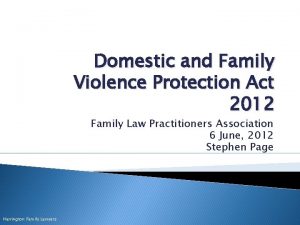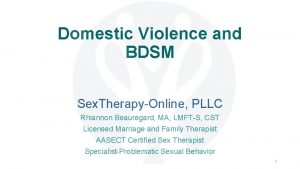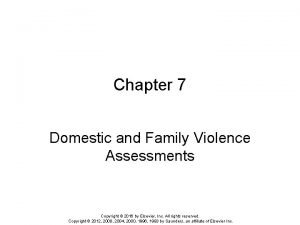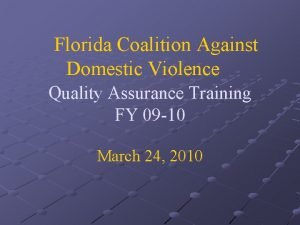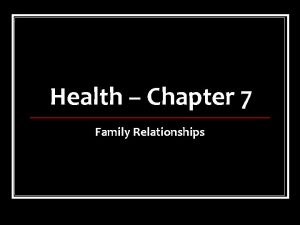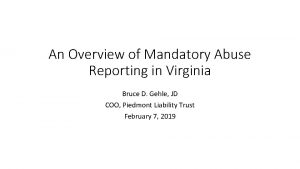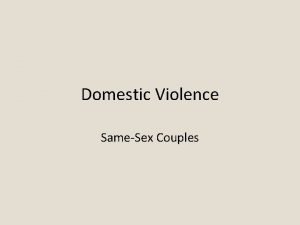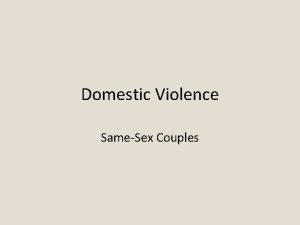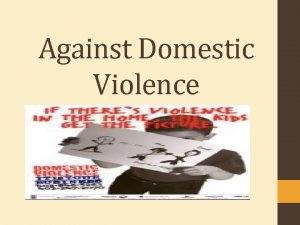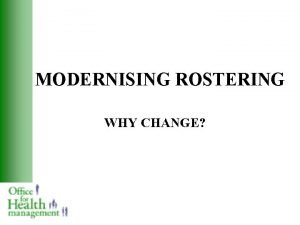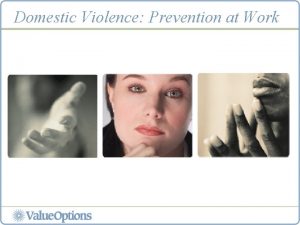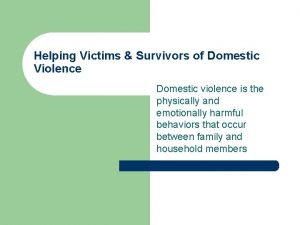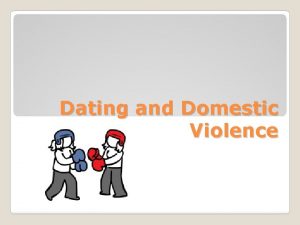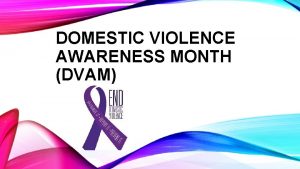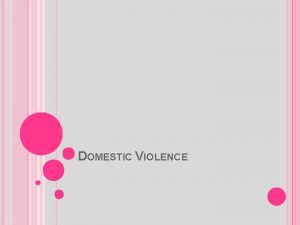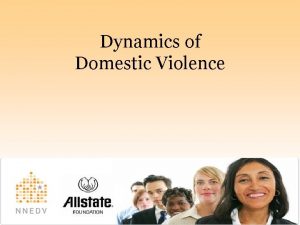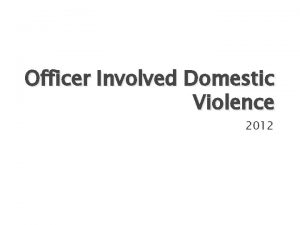The Domestic Violence Act modernising domestic violence laws




























- Slides: 28

The Domestic Violence Act - modernising domestic violence laws and criminalising domestic abuse – does it do enough? Dr Louise Crowley School of Law UCC

Prevalence of domestic abuse • Women’s Aid Impact Report 2018 • 1 in 5 women have suffered partner abuse • 2018 – 16, 994 disclosures of DV against women and 3, 728 against children during 19, 089 contacts with Women's Aid Direct Services • Of the 16, 994 disclosures • 11, 112 emotional abuse • 3, 816 physical abuse • 526 sexual abuse • 1, 540 financial abuse MOVE Conference "A Safer Future Together" November 2019 2

Intimate Partner Femicide • 225 women have died violently in Ireland (1996 – 2018) - 61% killed in their own homes - Of resolved cases, 56% by partner/ex partner - Another 31% killed by someone they knew - 87% killed by someone known to them (Women’s Aid Femicide Watch 2018) MOVE Conference "A Safer Future Together" November 2019 3

Courts Service Annual Report 2018 • 18, 572 court applications to the District Court -16% increase from 2017 • 14% increase in applications for safety orders • 9% increase in applications for protection orders • 38% increase in applications for interim barring orders • 28% increase in applications for barring orders (having decreased between 2016 -2017). MOVE Conference "A Safer Future Together" November 2019 4

Domestic Violence – court statistics DISTRICT COURT: DOMESTIC VIOLENCE – TRENDS 2018 2017 2016 2015 Barring order applications 3343 2, 613 2, 658 2, 638 Barring orders granted 946 822 Protection order applications 6390 5, 869 5, 365 5, 108 Protection orders granted* 5515 5, 006 4, 627 4, 225 Safety order applications 7280 6, 368 6, 069 5, 626 Safety orders granted 2327 2, 255 3, 316 1, 917 Interim barring order applications 1270 917 880 731 Interim barring orders granted 982 693 676 563 1, 329 859 MOVE Conference "A Safer Future Together" November 2019 5

Capacity to protect victims of domestic abuse frustrated • Historical reluctance to intervene • Limited view of the deserving victim • Over arching deference to property rights • Default reliance upon the victim to pursue civil law remedy • Mis-classification of offences – under stating of prevalence and severity • Absence of clarity as to evidentiary thresholds • Absence of judicial accountability and scrutiny • Resultant inconsistency and unpredictability • Lack of deconstructed court applications data MOVE Conference "A Safer Future Together" November 2019 6

Statutory overview • Family Law (Maintenance of Spouses and Children) Act 1976 • Family Law (Protection of Spouses and Children) Act 1981 • Domestic Violence Act 1996 • Domestic Violence (Amendment) Act 2002 • Civil Partnership and Certain Rights and Obligations of Cohabitants Act 2010 • Domestic Violence Act 2018 MOVE Conference "A Safer Future Together" November 2019 7

Recent law reforms – International Influences • The Council of Europe Convention on preventing and combating violence against women and domestic violence Domestic Violence Act 2018 • Directive 2012/29/EU – Directive establishing minimum standards on the rights, support and protection of victims of crime. Criminal Justice (Victims of Crime) Act 2017 MOVE Conference "A Safer Future Together" November 2019 8

Istanbul Convention - Article 52 • “Parties shall take the necessary legislative or other measures to ensure that the competent authorities are granted the power to order, in situations of immediate danger, a perpetrator of domestic violence to vacate the residence of the victim or person at risk for a sufficient period of time and to prohibit the perpetrator from entering the residence of or contacting the victim or person at risk. Measures taken pursuant to this article shall give priority to the safety of victims or persons at risk. ” MOVE Conference "A Safer Future Together" November 2019 9

Domestic Violence Act 2018 • Came into force on 1 January 2019. • Repeals and replaces all existing laws Remedies available • Barring Order • Interim Barring Order • Emergency Barring Order • Safety Order • Protection Order Introduces the criminal offence of coercive control MOVE Conference "A Safer Future Together" November 2019 10

Barring Order – who can apply? a) Spouse of the respondent b) Civil partner of the respondent c) Applicant has lived with the respondent in an intimate relationship prior to the application for a barring order d) Parent of the respondent who is of full age and is not dependent upon the parent In respect of c) and d) the barring order cannot be made where the respondent has a legal or beneficial interest in the property and - the applicant has no legal or beneficial interest, or - the applicant’s legal or beneficial interest is less than that of the respondent. MOVE Conference "A Safer Future Together" November 2019 11

Emergency barring order Who can apply? • Applicant has lived with the Respondent in an intimate relationship prior to the application (but is not the spouse, civil partner or relative) or the Applicant is a parent of the respondent, the Respondent being of full age and not dependent on the Applicant • Respondent has a legal or beneficial interest in the property but the Applicant has no such interest, or the Applicant’s legal or beneficial interest is less than that of the Respondent. Matters for consideration • Immediate risk of significant harm if an order is not made immediately • Maximum duration of 8 days • No new emergency order for a period of one month except in exceptional circumstances MOVE Conference "A Safer Future Together" November 2019 12

Safety Order Who can apply? Spouse of the respondent Civil partner of the respondent Person in an intimate relationship with respondent prior to application • Parent of the respondent and respondent is of full age and not dependent on applicant • Applicant is over 18, resides with the respondent in a non contractual relationship • Parent of a child, whose other parent is the respondent • • MOVE Conference "A Safer Future Together" November 2019 13

Factors relevant to the court in determining application for an order • • • • Any history of violence by the respondent on the applicant If respondent has a conviction for violence or threat of violence If violence by respondent on applicant is escalating Exposure of children to violence by respondent on applicant Any previous domestic violence order made against respondent Any history of animal cruelty by the respondent Any destruction of property by the respondent to the property and /or residence of the applicant Any recent separation between the parties Substance abuse including alcohol by any of the parties Access to weapons by any of the parties Applicants perception of risk to him/herself by the respondent Age, health including pregnancy of the applicant and any children Evidence of deterioration of welfare caused by fear of respondent Economic dependency by the applicant on the respondent MOVE Conference "A Safer Future Together" November 2019 14

Domestic Violence Act 2018 Views of the Child Express requirement that the court seek the views of a child who is capable of expressing them; court can appoint an expert to ascertain and convey those views Accompaniment (applicant but not respondent) - Permits accompaniment in court, in addition to legal representative, by an individual (including a support worker) of his/her choice - Court can refuse such permission where it would not be in the interests of justice for the individual concerned to accompany applicant – must explain reason for so refusing. Cross examination of victim/children by the respondent - Court must prevent re minors unless justice requires it. - Court can prevent re adult parties unless justice requires it. MOVE Conference "A Safer Future Together" November 2019 15

Domestic Violence Act 2018 Criminal offences for breach of orders Now heard in camera Anonymity of victim and accused Express, detailed confirmation of importance of anonymity in reporting of domestic violence criminal law proceedings Evidence by video link Amends related criminal legislation to permit evidence to be given by television link in criminal proceedings arising from the breach of an existing domestic violence order MOVE Conference "A Safer Future Together" November 2019 16

Judicial reasoning for decisions Where an application for intervention is made to the court, the court must give reasons for its decision – (a) To grant or refuse the application, (b) To make the order subject to exceptions or conditions, (c) To vary existing exceptions or conditions MOVE Conference "A Safer Future Together" November 2019 17

Domestic abuse as a criminal offence Historical challenges • Section 4(1) of the Non-Fatal Offences Against the Person Act 1997 provides that a person who intentionally or recklessly causes serious harm to another shall be guilty of an offence. • Longstanding reliance upon civil proceedings, onus on victim • Criminal law more typically relied upon where breach occurs 2014 Crime Investigation Inspectorate • Absence of comprehensive data in respect of incidence, reporting and conviction of domestic abuse • Incorrect recording of DV offences, absence of distinct CSO statistics in respect of acts of DV which were included with all other assaults - typically moved to the non-crime category of ‘Attention and Complaints’. • Compounded by absence of a formal risk assessment process to identify those at the highest level of risk of abuse, MOVE Conference "A Safer Future Together" November 2019 18

Domestic abuse as a criminal offence • DRCC submission to UN CEDAW (Jan 2017) • Policy of an Garda Síochána on Domestic Abuse Intervention (2017) • Pro-arrest policy where Garda has reasonable cause to suspect an offence has been committed and a power of arrest exists. • Sensitive to ongoing threat to injured party, and continuing risk that can remain. • Monitoring, recording and investigation. • Asserts that ‘”it should not be the case that victim is asked if the abuser should be arrested” MOVE Conference "A Safer Future Together" November 2019 19

UN CEDAW recommendations (a) Systematic collection and analysis of data, disaggregated appropriately (b) Ensure prosecutors and police are properly trained (c) Criminalise domestic violence and introduce a specific definitions (d) Provide adequate financial resources to service providers (e) Ratify the Council of Europe Convention on Preventing and Combating Violence against Women and Domestic Violence MOVE Conference "A Safer Future Together" November 2019 20

Criminal offence of coercive control • Knowingly and persistently engaging in behaviour that • Is controlling or coercive • Has a serious effect on a relevant person • A reasonable person would consider likely to have a serious effect on a relevant person • Behaviour has a serious effect if it causes the person – • To fear that violence will be used against him/her, or • Serious alarm or distress that has a substantial adverse impact on his or her usual day-to-day activities • Applicant is the spouse, civil partner or is/was in an intimate relationship with the accused MOVE Conference "A Safer Future Together" November 2019 21

How do we define/identify coercive control? • Definitions seek to capture the ‘cage’ of intimidating, degrading and regulatory practices engineered by abusers to inculcate fear and threat in victims’ everyday lives • Stark (2007) emphasizes the centrality of gender arguing that coercive control most frequently operates within heterosexual relationships in which men use ‘social norms of masculinity and femininity… to impose their will’ • Encourages criminal justice professionals to embrace coercive control as a process occurring over time rather than as a one-off event. (Barlow, Johnson, Walklate and Humphreys) MOVE Conference "A Safer Future Together" November 2019 22

Preliminary analysis of Eng/Wales • Current gender-neutral version of the legislation requires revision • Greater resourcing and training to improve understandings of the nature and impact of coercive control at all points of contact within the criminal justice process • Effective responses to domestic abuse need to be genuinely holistic. (Barlow, Johnson, Walklate and Humphreys) MOVE Conference "A Safer Future Together" November 2019 23

New Zealand – declined to introduce offence of coercive control • May in fact be unable to deliver in practice on the many benefits that it theoretically promises. • Will require significant reforms in practice and thinking • Successful prosecutions will require significant reliance on victim testimony, and ‘a breadth of evidence and complexity of factual analysis that the criminal justice system is not currently well equipped to provide’. • Ultimately could operate to further minimize the justice response to domestic abuse and undermine the validity of the experiences of victims (Tolmie 2018) MOVE Conference "A Safer Future Together" November 2019 24

Relationship between parties an aggravating factor in sentencing • When court is determining sentencing the fact of marriage/civil partnership/intimate relationship will be treated as an aggravating factor • Will require the court to impose a greater sentence unless exceptional circumstances exist Relevant offences: • Assault, rape under s. 4, sexual assault, aggravated sexual assault, or conspiring/procuring/inciting the commission of any of these offences MOVE Conference "A Safer Future Together" November 2019 25

Criminal Justice (Victims of Crime) Act 2017 • Right to receive comprehensive information on role of victim and services/entitlements of victims • Right to receive written acknowledgement of complaint giving contact details for further information • Right to be provided with information on progress of investigation and any court proceedings. • Right to be protected during investigation and proceedings • Right to an assessment to establish the measures necessary to protection victim from repeat victimisation • Right to be informed, of any decision not to institute a prosecution and right to request a review of that decision. • Right to receive information from Irish Prison Service of the release of offender MOVE Conference "A Safer Future Together" November 2019 26

Intervening with the perpetrator – role of the law? Domestic Violence Act 2018 • Referrals to Support Services • Obliges the court to provide an applicant with information on domestic violence support services. • When granting a barring/safety order the court may direct a respondent to engage with services to address issues relating to his/her behaviour to include (a) a domestic violence perpetrator programme, (b) an addiction service, (c) a counselling or psychotherapy service, or (d) a service in relation to financial planning. • The court may consider the engagement of the respondent with services, and the outcome of such engagement, when hearing an application for variation or appeal from an existing order or in respect of an alleged breach of an order. MOVE Conference "A Safer Future Together" November 2019 27

Challenges in the Irish context • Definition and understanding of ‘domestic violence’ • Consistency of interpretation and application of new laws • Interpretation of coercive control • Burden on victim as central witness • Consequences of pro arrest policy • Specialised judicial training • Dedicated family court facilities • Breadth of response to Istanbul obligations – education, awareness, supports, legal representation, housing, funding of perpetrator programmes and services MOVE Conference "A Safer Future Together" November 2019 28
 Domestic and family violence protection act 2012
Domestic and family violence protection act 2012 Domestic and family violence protection act 2012
Domestic and family violence protection act 2012 Domestic violence kink
Domestic violence kink Routine, universal screening for domestic violence means
Routine, universal screening for domestic violence means Florida coalition against domestic violence
Florida coalition against domestic violence Domestic violence in the hispanic community
Domestic violence in the hispanic community Three r's for stopping domestic violence
Three r's for stopping domestic violence Virginia mandatory reporting law domestic violence
Virginia mandatory reporting law domestic violence Useless laws weaken the necessary laws
Useless laws weaken the necessary laws Modifiers of human acts tagalog
Modifiers of human acts tagalog Macbeth act 3-5 summary
Macbeth act 3-5 summary Soil conservation and domestic allotment act
Soil conservation and domestic allotment act Soil conservation and domestic allotment act
Soil conservation and domestic allotment act Soil conservation and domestic allotment act
Soil conservation and domestic allotment act Chụp phim tư thế worms-breton
Chụp phim tư thế worms-breton ưu thế lai là gì
ưu thế lai là gì Thẻ vin
Thẻ vin Cái miệng nó xinh thế chỉ nói điều hay thôi
Cái miệng nó xinh thế chỉ nói điều hay thôi Các châu lục và đại dương trên thế giới
Các châu lục và đại dương trên thế giới Từ ngữ thể hiện lòng nhân hậu
Từ ngữ thể hiện lòng nhân hậu Bổ thể
Bổ thể Tư thế ngồi viết
Tư thế ngồi viết Diễn thế sinh thái là
Diễn thế sinh thái là V cc cc
V cc cc Phép trừ bù
Phép trừ bù Thể thơ truyền thống
Thể thơ truyền thống Bài hát chúa yêu trần thế alleluia
Bài hát chúa yêu trần thế alleluia Khi nào hổ con có thể sống độc lập
Khi nào hổ con có thể sống độc lập đại từ thay thế
đại từ thay thế
